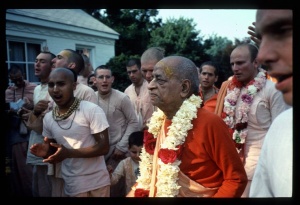CC Adi 3.40 (1975)

A.C. Bhaktivedanta Swami Prabhupada
TEXT 40
- kali-yuge yuga-dharma--nāmera pracāra
- tathi lāgi' pīta-varṇa caitanyāvatāra
SYNONYMS
kali-yuge—in the Age of Kali; yuga-dharma—the religious practice for the age; nāmera—of the holy name; pracāra—propagation; tathi—this; lāgi'-for; pīta-varṇa—having a yellow color; caitanya-avatāra—the incarnation of Lord Caitanya.
TRANSLATION
The religious practice for the Age of Kali is to broadcast the glories of the holy name. Only for this purpose has the Lord, in a yellow color, descended as Lord Caitanya.
PURPORT
In this Age of Kali the practical system of religion for everyone is the chanting of the name of Godhead. This was introduced in this age by Lord Caitanya. Bhakti-yoga actually begins with the chanting of the holy name, as confirmed by Madhvācārya in his commentary on the Muṇḍaka Upaniṣad. He quotes this verse from the Nārāyaṇa-saṁhitā:
- dvāparīyair janair viṣṇuḥ
- pañcarātrais tu kevalaiḥ
- kalau tu nāma-mātreṇa
- pūjyate bhagavān hariḥ
"In the Dvāpara-yuga people should worship Lord Viṣṇu only by the regulative principles of the Nārada-pañcarātra and other such authorized books. In the Age of Kali, however, people should simply chant the holy names of the Supreme Personality of Godhead." The Hare Kṛṣṇa mantra is specifically mentioned in many Upaniṣads, such as the Kali-santaraṇa Upaniṣad, where it is said:
- hare kṛṣṇa hare kṛṣṇa
- kṛṣṇa kṛṣṇa hare hare
- hare rāma hare rāma
- rāma rāma hare hare
- iti ṣoḍaśakaṁ nāmnāṁ
kali-kalmaṣa-nāśanam
- nātaḥ parataropāyaḥ
- sarva-vedeṣu dṛśyate
"After searching through all the Vedic literature one cannot find a method of religion more sublime for this age than the chanting of Hare Kṛṣṇa."